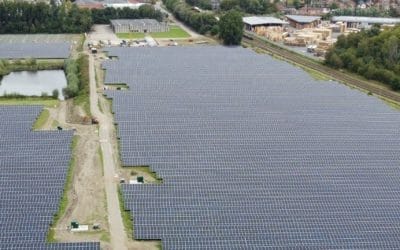By Mark Futyan, CEO Anesco
I was delighted to take part in an expert panel discussion recently, exploring the ‘coming of age’ of energy storage in the UK and in particular, what the key challenges and opportunities are and how the market is expected to evolve moving forward.
As a company that has been at the forefront of this sector since day one – installing the UK’s first utility scale battery storage unit back in 2014 and developing one fifth of the UK’s total storage capacity – this is naturally a topic we are very passionate about. Especially in relation to revenue stacking and optimising asset performance for our customers.
There is no doubt the last year has been a challenging one for the sector, but I believe we are starting to see some green shoots in spite of the COVID-19 pandemic.
Here is an overview of the key discussion points and takeaways from the conference. To find out more or to discuss any of the issues raised here, please feel free to get in touch.
UK battery storage landscape
Energy storage is recognised globally as a key technology required to support the transition to a low carbon energy system, maintaining grid stability as intermittent renewables become widespread.
In Europe, the UK remains the dominant market for battery storage with 900MW now in operation. Although there has been a fall in new build volumes, investment continues, particularly by sector specific funds such as Gresham House and Gore Street Capital.
According to Inspiratia, there is a strong development pipeline for future market growth, with nearly 4GW projects having been granted planning permission in the UK alone.
Although the sector has suffered some adverse regulatory changes in the past few years, more recently, there have been more positive shifts, including:
- The reinstatement of the Capacity Market (CM) with 4.7GW battery projects successfully prequalifying for the T-4 auction, the majority targeting 15-year contracts
- Plans to reinstate solar PV and onshore wind back into the Contracts for Difference (CfD) scheme, accelerating the energy transition and supporting the need for flexibility, and
- Changes to National Grid’s Balancing Mechanism (BM) enabling smaller battery assets to access for the first time
Achieving optimal value in the market
The energy storage value stack is uniquely complex with a whole host of different revenue streams available spanning capacity, wholesale, balancing services and frequency regulation. Then there is state of charge management and cell degradation to consider on top. The market complexity, combined with growing capacity in the market, has opened up the need for asset optimisation services.
This unique challenge has been tackled by a range of market participants, including trading houses, aggregators and specialist firms. More recently, Anesco announced its intention to develop an offering in the market, supported by our long running experience in optimising nearly 100MW of flexible capacity in the UK. Watch this space for further updates!
Investor confidence and merchant risk
In the early days of battery storage, revenues could be underpinned by long term Enhanced Frequency Response (EFR) and Capacity Market contracts. The market for flexibility has since evolved and investments in batteries are now predominantly exposed to merchant markets. As a result, we are seeing a re-alignment in who is investing in new capacity, away from fixed income funds and utilities, towards sector focused investors. It is important that investors have a deep understanding of the market and are able to manage the merchant risks involved.
Increasingly, diversification across different revenue streams can help with risk management. The emergence of comprehensive battery optimisation services can help spread short term market risk across wholesale, balancing and frequency regulation.
The benefits of co-location
In today’s market, the main benefit of co-locating storage with renewables is to reduce combined construction costs. In the long term, we might start to see a market signal to use excess wind or solar generation for charging, with discharge from the battery at peak times, such as in the evening. However, today, that is rarely the optimal way to utilise the assets, so revenue synergies are limited.
Anesco was proud to unveil the UK’s first subsidy-free solar farm, Clayhill, back in 2017 – a site which combines 10MW solar PV with 6MW battery storage. In the last three years, we have benefited from construction and operational insights that will help shape the market going forward.
A further challenge highlighted by the panel was that renewables and storage are different asset classes. Renewables are typically subsidised with de-risked revenue streams and even new subsidy free solar projects are exposed to deeper wholesale markets, as opposed to shallower flex markets. While there are some investors active in both asset classes, the combination is a relatively unique proposition.
6 key predictions for the future of the storage industry
- There will be a realignment in the market, with different types of investors coming forward.
- Supply chain efficiencies will increase, reducing overall build costs.
- With the reduction in embedded benefits, we will see an increase in larger scale projects, close to the 50MW planning threshold.
- COVID19 is not expected to have a lasting impact on the market. Wholesale prices are depressed by low demand, but the need for flexibility is just as high.
- Competition will increase as more capacity comes to market, putting downward pressure on frequency regulation prices.
- Market optimisation services will become more important as investment shifts away from utilities and the array of revenue streams expands.
Conclusion
After a challenging period for storage developers and investors, the future once again looks bright with some exciting developments in the market and a strong forward pipeline. Energy storage remains an essential part of the energy mix, complementing renewables, as we transition towards net zero.
The ‘Energy Storage Virtual Conference’ was hosted by Inspiratia on 5 May 2020. Discussions are planned to continue at a face-to-face event being held in September. For more information, visit www.inspiratia.com.





